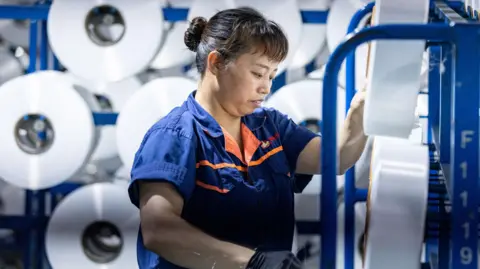**China’s Economic Growth Faces Challenges Amid Trade Turmoil**
In recent times, China’s economic growth has exhibited notable signs of slowing down, largely influenced by ongoing trade tensions and the crisis in its property market. This situation has emerged as a result of actions from international powers, notably the tariffs imposed during Donald Trump’s presidency that have strained China’s trade dynamics. In the latest figures released by the National Bureau of Statistics, the world’s second-largest economy recorded a growth rate of 5.2% in the quarter ending June, down from a 5.4% growth in the previous quarter.
Despite these challenges, the Chinese economy has managed to stave off a severe downturn, thanks to recent measures initiated by Beijing aimed at bolstering economic activity. Furthermore, a fragile truce regarding tariffs with the United States could be contributing to this stabilization, according to officials.
The statement from the National Bureau of Statistics emphasized that the economy “withstood pressure and made steady improvement despite challenges.” These sentiments suggest that while growth is slowing, it still exhibits resilience amidst external pressures.
On the residential front, the real estate market continues to face struggles. Official data disclosed that new home prices in China registered their most significant monthly decline in eight months during June. Such findings point to ongoing struggles within the real estate sector, even after multiple initiatives undertaken to support property prices, indicating that recovery in this segment remains elusive.
Economists have begun revising their forecasts, with some projecting that China may not achieve its annual growth target of “around 5%.” Opinions vary regarding the extent to which growth may falter, yet Dan Wang, the director for China at the consultancy Eurasia Group, expressed belief in a minimum growth floor of 4%, which he considers the politically acceptable benchmark for the country.
Trade relations with the United States have certainly intensified the economic landscape for China. A tariff war initiated by Chinese President Xi Jinping and former President Trump led to the imposition of hefty duties such as a 145% levy on Chinese imports, with reciprocation from Beijing in the form of a 125% tariff on select US goods.
The tensions had seemed partly alleviated after negotiations held in Geneva and London, where both parties temporarily paused the tariffs. They now face a deadline of August 12 to finalize a more sustainable long-term trade agreement, but uncertainties persist, complicating the path forward.
Moreover, the United States has extended its tariffs beyond China, imposing heavy levies against other countries that maintain close economic relationships with China. This broader scope of sanctions further emphasizes the tangled nature of global trade dynamics as geopolitical circumstances remain fluid.
In summary, China’s current economic landscape reveals a complicated interplay of growth pressures exacerbated by international trade disputes and domestic market challenges. The government’s initiatives are gearing towards providing support, yet the ongoing crises in sectors such as real estate, compounded by tumultuous international relations, pose substantial hurdles for future growth prospects. As such, experts and policymakers closely monitor these developments, hoping for a recovery while navigating through the complexities of the global economic framework.











